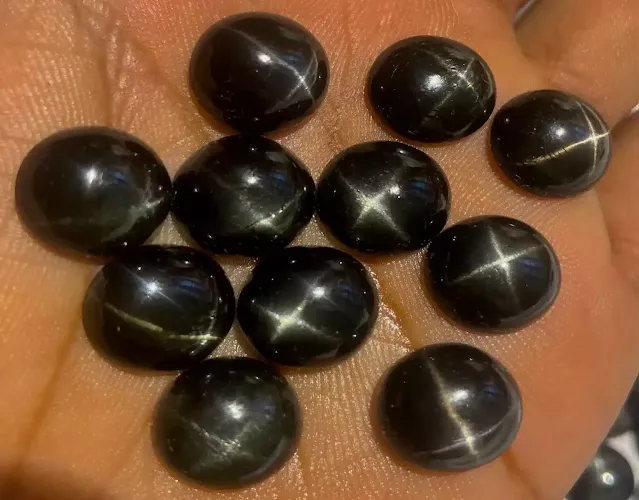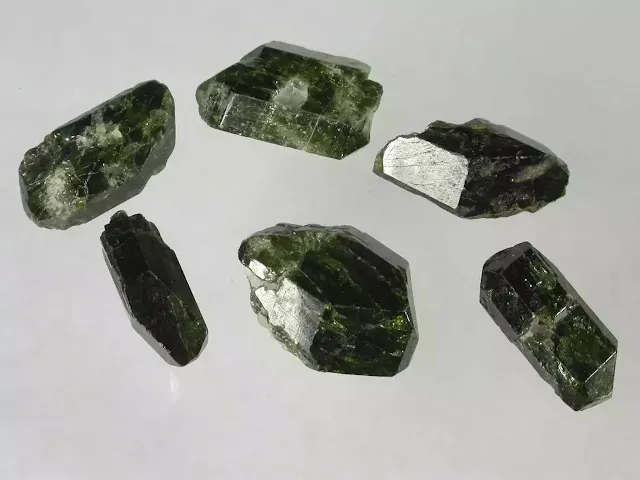Black Star Diopside
Black Star Diopside is a beautiful gemstone variety of the mineral diopside, a calcium magnesium silicate. It's known for its unique star-like effect, called asterism, a four-rayed star that appears when light hits the stone at a certain angle. This effect is caused by tiny inclusions of rutile needles within the gemstone that reflect light and create the star.
It belongs to the pyroxene mineral group and gets its name from the Greek words "di" meaning "two" and "opsis" meaning "vision." This relates to its dual nature: appearing opaque in darkness and showcasing a chatoyancy (star effect) in light.
 |
| Black Star Diopside Gemstones |
Black Star Diopside Properties
Color: Black Star Diopside typically ranges in color from deep black to dark green, although some rare specimens can be grayish or brownish. The black or greenish color comes from traces of iron and chromium within the crystal structure.
Transparency: Black Star Diopside is generally transparent to translucent.
Luster: The luster of Black Star Diopside is vitreous to dull.
Crystal System: It crystallizes in the monoclinic crystal system.
Streak: The streak color of Black Star Diopside is usually white.
Hardness: It has a hardness of 5.5 to 6.6 on the Mohs scale, making it moderately hard.
Cleavage: Black Star Diopside exhibits distinct cleavage in two directions, forming nearly right angles.
Fracture: The fracture of Black Star Diopside is typically uneven to conchoidal.
Habits and Forms: It commonly occurs as prismatic crystals or granular masses. It can also be found as rounded grains in alluvial deposits.
Density: The density of Black Star Diopside ranges from approximately 3.22 to 3.38 g/cm³.
Specific Gravity: Its specific gravity typically falls between 3.22 to 3.38.
Fluorescence: Black Star Diopside may exhibit weak fluorescence under ultraviolet light, but this property is not commonly observed.
Pleochroism: Black Star Diopside may show weak pleochroism, where different colors can be observed when viewed from different angles.
Refractive Index: The refractive index of Black Star Diopside ranges from approximately 1.663 to 1.729, depending on the composition and specific variety.
Inclusions: Black Star Diopside may contain needle-like inclusions of magnetite or hematite, which are responsible for the star effect observed in some specimens. These inclusions can create a four-rayed star when the stone is cut into a cabochon shape and properly oriented.
Jewelry Uses
Black Star Diopside has found its way into the hearts and designs of jewelry artisans worldwide. Black Star Diopside is often cut into cabochons to showcase its star effect. Cabochons are highly polished, rounded gemstones with a flat back and a smooth, domed surface that highlights the star. These cabochons are then set into various types of jewelry, such as rings, earrings, pendants, and bracelets. The star effect, when expertly showcased, adds a touch of cosmic wonder to each creation, making Black Star Diopside a sought-after gem for those seeking distinctive and eye-catching jewelry
Black Star Diopside Occurrence
Black Star Diopside occurs in two main geological settings:
Igneous Rocks: This is the most common occurrence for Black Star Diopside. It forms within igneous rocks, particularly those formed by volcanic activity. These rocks are rich in magnesium and calcium, which are essential components of Black Star Diopside's chemical makeup.
Metamorphosed Limestone Deposits: Less frequently, Black Star Diopside can be found in metamorphosed limestone deposits. When limestone undergoes extreme heat and pressure during metamorphism, it can recrystallize and form new minerals, including Black Star Diopside.
 |
| Black Star Diopside cabochons |
Where is black star diopside found?
Black Star Diopside originates from regions with significant volcanic activity and is found in igneous rocks. The most notable deposits of Black Star Diopside come from several countries:
India: One of the major sources, known for producing high-quality Black Star Diopside, and the gemstone is often mined in areas such as Rajasthan.
Russia: Particularly the Ural Mountains, where the black star variety was first discovered in the 19th century.
Sri Lanka: Another source for Black Star Diopside, known for its deep color and transparency.
Myanmar (Burma): Can also be a source of Black Star Diopside.
Italy: Less common, but some deposits exist in Italy as well.
 |
| Raw Black Star Diopside |
Meaning and Symbolism of Black Star Diopside
Black Star Diopside carries a rich history of symbolism that varies across cultures and belief systems. Here's a breakdown of some common meanings associated with this gemstone:
Protection: Black Star Diopside is believed to offer protection against negative energies and psychic attacks. It's seen as a shield, deflecting negativity and promoting a sense of security.
Grounding and Stability: The deep black color and connection to the Earth's formation process imbue Black Star Diopside with grounding energy. It's believed to promote a sense of stability, balance, and centeredness.
Transformation and Rebirth: The play of light and dark within the stone, along with its association with past-life experiences, makes Black Star Diopside a symbol of transformation and rebirth. It's believed to aid in releasing old patterns and embracing positive change.
Healing: Metaphysical beliefs associate Black Star Diopside with emotional and physical healing. Sometimes called the "crying stone," it's believed to help release pent-up emotions and promote emotional healing. It may also be seen as supportive for physical well-being.
Metaphysical Properties: Some individuals believe that Black Star
Diopside has metaphysical properties, including the ability to enhance
emotional well-being, bring about positive changes, and offer
protection. As with many gemstones, these beliefs are not scientifically
proven.
Caring for Black Star Diopside
To ensure the longevity of Black Star Diopside jewelry, it's essential to handle it with care. Avoid exposing the gem to harsh chemicals and store it separately from other jewelry to prevent scratches. Regular cleaning with a soft cloth and mild soap will help maintain its luster and beauty.
Conclusion
In summary, Black Star Diopside emerges as a distinctive gemstone with geological roots in igneous and metamorphic rocks. Its physical properties, including color, transparency, and hardness, make it a sought-after material for jewelry crafting. Whether admired for its aesthetic allure or considered for its alleged metaphysical attributes, Black Star Diopside occupies a unique niche within the realm of gemstones, contributing to the ongoing narrative of Earth's geological marvels.

%20(1).webp)






